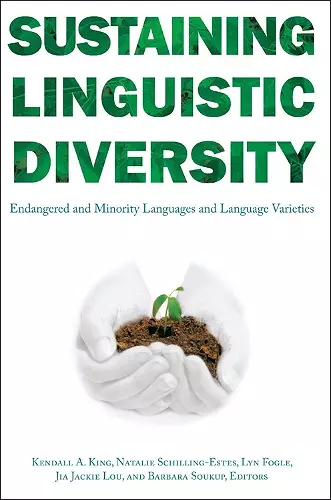Sustaining Linguistic Diversity
Endangered and Minority Languages and Language Varieties
Natalie Schilling editor Kendall A King editor Lyn Wright Fogle editor Jia Jackie Lou editor Barbara Soukup editor
Format:Paperback
Publisher:Georgetown University Press
Published:6th Mar '08
Currently unavailable, and unfortunately no date known when it will be back

The authors provide a visionary glimpse into the linguistic future of humanity, and offer some well-tested strategies to secure language diversity for future generations. -- K. David Harrison, assistant professor, Department of Linguistics, Swarthmore College and director of research, Living Tongues Institute for Endangered Languages Once again, a Georgetown Round Table [volume] manages to summarize the state of the art of an important field of linguistics, consolidate our understanding, present fresh data, and suggest lines for future research and theory. Many of the [chapters] in this volume will become classics in the study of endangered languages and the underlying causes of language loss and maintenance. -- Bernard Spolsky, professor emeritus, Bar-Ilan University
Presents an overview of work in defining, documenting, and developing the world's smaller languages and language varieties. This book shows how we define endangerment - how languages and language varieties are best classified, what the implications of such classifications are, and who should have the final say in making them.In the last three decades, the field of endangered and minority languages has evolved rapidly, moving from the initial dire warnings of linguists to a swift increase in the number of organizations, funding programs, and community-based efforts dedicated to documentation, maintenance, and revitalization. "Sustaining Linguistic Diversity" brings together cutting-edge theoretical and empirical work from leading researchers and practitioners in the field. Together, these contributions provide a state-of-the-art overview of current work in defining, documenting, and developing the world's smaller languages and language varieties.The book begins by grappling with how we define endangerment - how languages and language varieties are best classified, what the implications of such classifications are, and who should have the final say in making them. The contributors then turn to the documentation and description of endangered languages and focus on best practices, methods and goals in documentation, and on current field reports from around the globe. The latter part of the book analyzes current practices in developing endangered languages and dialects and particular language revitalization efforts and outcomes in specific locations. Concluding with critical calls from leading researchers in the field to consider the human lives at stake, "Sustaining Linguistic Diversity" reminds scholars, researchers, practitioners, and educators that linguistic diversity can only be sustained in a world where diversity in all its forms is valued.
Sustaining Linguistic Diversity is an excellent contribution to the growing literature dealing with language endangerment. It provides a thoughtful and reflective approach not only to the overarching questions related to language endangerment, but also in-depth analysis of a number of challenging and often puzzling case studies. This is a book that any serious applied linguist ought to read. Language Problems and Language Planning [The] diversity of the material, the inclusion of plenty of varied linguistic data, tables and charts, and the range of viewpoints offered make this a refreshing book that will be enjoyed and valued by many. Journal of Sociolinguistics
ISBN: 9781589011922
Dimensions: unknown
Weight: 363g
246 pages